使用 ECL EKF
本文主要回答使用 ECL EKF 算法的常见问题。
PX4 状态估计概述视频, PX4 开发者峰会 2019, (Dr. Paul Riseborough) 对状态估计器进行了概述,并且还进一步介绍了2018/2019年以来的重大变化以及2020年期间计划的改进措施。
什么是 ECL EKF?
估计和控制库(ECL)使用扩展卡尔曼滤波算法(EKF)来处理传感器的测量信息,并提供如下状态量的估计值:
- 定义由北-东-地的当地地理坐标系到X-Y-Z机体坐标系旋转角度的姿态四元数
- IMU传感器位置处的速度-北-东-地 (m/s)
- IMU传感器位置处的空间坐标 - 北-东-地 (m)
- IMU 角度误差估计 - X, Y, Z (rad)
- IMU 速度误差估计 - X, Y, Z(m/s)
- 地理地磁 - 北-东-地 (gauss)
- 机体偏置磁场 - X, Y, Z (gauss)
- 风速 - 北-东 (m/s)
EKF在延迟的“融合时程”下运行,从而适应不同传感器测量值相对IMU的时间延迟。 为了保证所有传感器数据都能在在正确的时间内使用,每个传感器的数据都是按照先入先出(FIFO)队列进行缓存,并由EKF从缓存区中读取。 每个传感器的延迟补偿通过EKF2_*_DELAY 参数进行控制。
互补滤波器根据缓冲的 IMU 数据将状态变量从“融合时程”向前传播到当前时间。 互补滤波器的时间常数由 EKF2_TAU_VEL 以及 EKF2_TAU_POS 参数共同控制。
“融合时程”延迟和缓冲区长度由
EKF2_*_DELAY参数中的最大值决定。 如果并未使用某个传感器,建议将其对应的时间延迟置零。 降低“融合时程”延迟可以减小互补滤波器讲状态变量前向传播至当前时间的误差。
位置及速度状态变量在输出至控制回路之前会根据IMU与机体坐标系之间的偏置量进行修正。 IMU传感器在机体坐标系下的相对位置由EKF2_IMU_POS_X,Y,Z 参数定义。
EKF仅将IMU数据用于状态预测。 在EKF推导过程中并未使用IMU数据。 使用 Matlab symbolic toolbox 推导得到用于进行协方差预测、状态更新、协方差更新的线性代数方程,相关内容详见: Matlab Symbolic Derivation.
它用到了哪些传感器测量值?
EKF滤波器由多种运行模式以适应不同的传感器测量组合。 滤波器在启动时会检查传感器的最小可行组合,并且在完成初始倾斜,偏航和高度对准之后,进入提供旋转,垂直速度,垂直位置,IMU 角偏差和 IMU 速度偏差估计的模式。
此模式下滤波器需要 IMU 数据,一个偏航角数据源(磁力计或外部视觉)和一个高度数据源。 该数据集是所有EKF运行模式的最低需求数据。 在此基础上可以使用其它传感器数据来估计额外的状态变量。
IMU
- Three axis body fixed Inertial Measurement unit delta angle and delta velocity data at a minimum rate of 100Hz. Note: Coning corrections should be applied to the IMU delta angle data before it is used by the EKF.
Magnetometer
Three axis body fixed magnetometer data (or external vision system pose data) at a minimum rate of 5Hz is required. Magnetometer data can be used in two ways:
- Magnetometer measurements are converted to a yaw angle using the tilt estimate and magnetic declination. This yaw angle is then used as an observation by the EKF. This method is less accurate and does not allow for learning of body frame field offsets, however it is more robust to magnetic anomalies and large start-up gyro biases. It is the default method used during start-up and on ground.
- The XYZ magnetometer readings are used as separate observations. This method is more accurate and allows body frame offsets to be learned, but assumes the earth magnetic field environment only changes slowly and performs less well when there are significant external magnetic anomalies.
The logic used to select these modes is set by the EKF2_MAG_TYPE parameter.
The option is available to operate without a magnetometer, either by replacing it using yaw from a dual antenna GPS or using the IMU measurements and GPS velocity data to estimate yaw from vehicle movement.
Height
A source of height data - either GPS, barometric pressure, range finder or external vision at a minimum rate of 5Hz is required.
The primary source of height data is controlled by the EKF2_HGT_MODE parameter.
If these measurements are not present, the EKF will not start. When these measurements have been detected, the EKF will initialise the states and complete the tilt and yaw alignment. When tilt and yaw alignment is complete, the EKF can then transition to other modes of operation enabling use of additional sensor data:
Correction for Static Pressure Position Error
Barometric pressure altitude is subject to errors generated by aerodynamic disturbances caused by vehicle wind relative velocity and orientation. This is known in aeronautics as static pressure position error. The EKF2 module that uses the ECL/EKF2 estimator library provides a method of compensating for these errors, provided wind speed state estimation is active.
For platforms operating in a fixed wing mode, wind speed state estimation requires either Airspeed and/or Synthetic Sideslip fusion to be enabled.
For multi-rotors, fusion of Drag Specific Forces can be enabled and tuned to provide the required wind velocity state estimates.
The EKF2 module models the error as a body fixed ellipsoid that specifies the fraction of dynamic pressure that is added to/subtracted from the barometric pressure - before it is converted to a height estimate. See the following parameter documentation for information on how to use this feature:
GPS
Position and Velocity Measurements
GPS measurements will be used for position and velocity if the following conditions are met:
- GPS use is enabled via setting of the EKF2_AID_MASK parameter.
- GPS quality checks have passed. These checks are controlled by the EKF2_GPS_CHECK and
EKF2_REQ_*parameters. - GPS height can be used directly by the EKF via setting of the EKF2_HGT_MODE parameter.
Yaw Measurements
Some GPS receivers such as the Trimble MB-Two RTK GPS receiver can be used to provide a heading measurement that replaces the use of magnetometer data. This can be a significant advantage when operating in an environment where large magnetic anomalies are present, or at latitudes here the earth's magnetic field has a high inclination. Use of GPS yaw measurements is enabled by setting bit position 7 to 1 (adding 128) in the EKF2_AID_MASK parameter.
Yaw From GPS Velocity
The EKF runs an additional multi-hypothesis filter internally that uses multiple 3-state Extended Kalman Filters (EKF's) whose states are NE velocity and yaw angle. These individual yaw angle estimates are then combined using a Gaussian Sum Filter (GSF). The individual 3-state EKF's use IMU and GPS horizontal velocity data (plus optional airspeed data) and do not rely on any prior knowledge of the yaw angle or magnetometer measurements. This provides a backup to the yaw from the main filter and is used to reset the yaw for the main 24-state EKF when a post-takeoff loss of navigation indicates that the yaw estimate from the magnetometer is bad. This will result in an Emergency yaw reset - magnetometer use stopped message information message at the GCS.
Data from this estimator is logged when ekf2 replay logging is enabled and can be viewed in the yaw_estimator_status message. The individual yaw estimates from the individual 3-state EKF yaw estimators are in the yaw fields. The GSF combined yaw estimate is in the yaw_composite field. The variance for the GSF yaw estimate is in the yaw_variance field. All angles are in radians. Weightings applied by the GSF to the individual 3-state EKF outputs are in theweight fields.
This also makes it possible to operate without any magnetometer data or dual antenna GPS receiver for yaw provided some horizontal movement after takeoff can be performed to enable the yaw to become observable. To use this feature, set EKF2_MAG_TYPE to none (5) to disable magnetometer use. Once the vehicle has performed sufficient horizontal movement to make the yaw observable, the main 24-state EKF will align it's yaw to the GSF estimate and commence use of GPS.
Dual Receivers
Data from GPS receivers can be blended using an algorithm that weights data based on reported accuracy (this works best if both receivers output data at the same rate and use the same accuracy). The mechanism also provides automatic failover if data from a receiver is lost (it allows, for example, a standard GPS to be used as a backup to a more accurate RTK receiver). This is controlled by the EKF2_GPS_MASK parameter.
The EKF2_GPS_MASK parameter is set by default to disable blending and always use the first receiver, so it will have to be set to select which receiver accuracy metrics are used to decide how much each receiver output contributes to the blended solution. Where different receiver models are used, it is important that the EKF2_GPS_MASK parameter is set to a value that uses accuracy metrics that are supported by both receivers. For example do not set bit position 0 to true unless the drivers for both receivers publish values in the s_variance_m_s field of the vehicle_gps_position message that are comparable. This can be difficult with receivers from different manufacturers due to the different way that accuracy is defined, e.g. CEP vs 1-sigma, etc.
The following items should be checked during setup:
- Verify that data for the second receiver is present. This will be logged as
vehicle_gps_position_1and can also be checked when connected via the nsh console using the commandlistener vehicle_gps_position -i 1. The GPS_2_CONFIG parameter will need to be set correctly. - Check the
s_variance_m_s,ephandepvdata from each receiver and decide which accuracy metrics can be used. If both receivers output sensibles_variance_m_sandephdata, and GPS vertical position is not being used directly for navigation, then setting EKF2_GPS_MASK to 3 is recommended. Where onlyephdata is available and both receivers do not outputs_variance_m_sdata, set EKF2_GPS_MASK to 2. Bit position 2 would only be set if the GPS had been selected as a primary height source with the EKF2_HGT_MODE parameter and both receivers output sensibleepvdata. - The output from the blended receiver data is logged as
ekf_gps_position, and can be checked whilst connect via the nsh terminal using the commandlistener ekf_gps_position. - Where receivers output at different rates, the blended output will be at the rate of slower receiver. Where possible receivers should be configured to output at the same rate.
GPS Performance Requirements
For the ECL to accept GPS data for navigation, certain minimum requirements need to be satisfied over a period of 10 seconds (minimums are defined in the EKF2REQ* parameters)
The table below shows the different metrics directly reported or calculated from the GPS data, and the minimum required values for the data to be used by ECL. In addition, the Average Value column shows typical values that might reasonably be obtained from a standard GNSS module (e.g. uBlox M8 series) - i.e. values that are considered good/acceptable.
| Metric | Minimum required | Average Value | Units | Notes |
|---|---|---|---|---|
| eph | 3 (EKF2_REQ_EPH) | 0.8 | m | Standard deviation of horizontal position error |
| epv | 5 (EKF2_REQ_EPV) | 1.5 | m | Standard deviation of vertical position error |
| Number of satellites | 6 (EKF2_REQ_NSATS) | 14 | - | |
| Speed variance | 0.5 | 0.3 | m/s | |
| Fix type | 3 | 4 | - | |
| hpos_drift_rate | 0.1 (EKF2_REQ_HDRIFT) | 0.01 | m/s | Drift rate calculated from reported GPS position (when stationary). |
| vpos_drift_rate | 0.2 (EKF2_REQ_VDRIFT) | 0.02 | m/s | Drift rate calculated from reported GPS altitude (when stationary). |
| hspd | 0.1 (EKF2_REQ_SACC) | 0.01 | m/s | Filtered magnitude of reported GPS horizontal velocity. |
The
hpos_drift_rate,vpos_drift_rateandhspdare calculated over a period of 10 seconds and published in theekf2_gps_drifttopic. Note thatekf2_gps_driftis not logged!
Range Finder
Range finder distance to ground is used by a single state filter to estimate the vertical position of the terrain relative to the height datum.
If operating over a flat surface that can be used as a zero height datum, the range finder data can also be used directly by the EKF to estimate height by setting the EKF2_HGT_MODE parameter to 2.
Airspeed
Equivalent Airspeed (EAS) data can be used to estimate wind velocity and reduce drift when GPS is lost by setting EKF2_ARSP_THR to a positive value. Airspeed data will be used when it exceeds the threshold set by a positive value for EKF2_ARSP_THR and the vehicle type is not rotary wing.
Synthetic Sideslip
Fixed wing platforms can take advantage of an assumed sideslip observation of zero to improve wind speed estimation and also enable wind speed estimation without an airspeed sensor. This is enabled by setting the EKF2_FUSE_BETA parameter to 1.
Multicopter Wind Estimation using Drag Specific Forces
Multi-rotor platforms can take advantage of the relationship between airspeed and drag force along the X and Y body axes to estimate North/East components of wind velocity. This is enabled by setting bit position 5 in the EKF2_AID_MASK parameter to true. The relationship between airspeed and specific force (IMU acceleration) along the X and Y body axes is controlled by the EKF2_BCOEF_X and EKF2_BCOEF_Y parameters which set the ballistic coefficients for flight in the X and Y directions respectively. The amount of specific force observation noise is set by the EKF2_DRAG_NOISE parameter.
These can be tuned by flying the vehicle in Position mode repeatedly forwards/backwards between rest and maximum maximum speed, adjusting EKF2_BCOEF_X so that the corresponding innovation sequence in the ekf2_innovations_0.drag_innov[0] log message is minimised. This is then repeated for right/left movement with adjustment of EKF2_BCOEF_Y to minimise the ekf2_innovations_0.drag_innov[1] innovation sequence. Tuning is easier if this testing is conducted in still conditions.
If you are able to log data without dropouts from boot using SDLOG_MODE = 1 and SDLOG_PROFILE = 2, have access to the development environment, and are able to build code, then we recommended you fly once and perform the tuning on logs generated via EKF2 Replay of the flight data.
Optical Flow
Optical flow data will be used if the following conditions are met:
- Valid range finder data is available.
- Bit position 1 in the EKF2_AID_MASK parameter is true.
- The quality metric returned by the flow sensor is greater than the minimum requirement set by the EKF2_OF_QMIN parameter.
External Vision System
Position, velocity or orientation measurements from an external vision system, e.g. Vicon, can be used:
- External vision system horizontal position data will be used if bit position 3 in the EKF2_AID_MASK parameter is true.
- External vision system vertical position data will be used if the EKF2_HGT_MODE parameter is set to 3.
- External vision system velocity data will be used if bit position 8 in the EKF2_AID_MASK parameter is true.
- External vision system orientation data will be used for yaw estimation if bit position 4 in the EKF2_AID_MASK parameter is true.
- External vision reference frame offset will be estimated and used to rotate the external vision system data if bit position 6 in the EKF2_AID_MASK parameter is true.
Either bit 4 (EV_YAW) or bit 6 (EV_ROTATE) should be set to true, but not both together. Following EKF2_AID_MASK values are supported when using with an external vision system.
| EKF_AID_MASK value | Set bits | Description |
|---|---|---|
| 321 | GPS + EV_VEL + ROTATE_EV | Heading w.r.t. North (Recommended) |
| 73 | GPS + EV_POS + ROTATE_EV | Heading w.r.t. North (Not recommended, use EV_VEL instead) |
| 24 | EV_POS + EV_YAW | Heading w.r.t. external vision frame |
| 72 | EV_POS + ROTATE_EV | Heading w.r.t. North |
| 272 | EV_VEL + EV_YAW | Heading w.r.t. external vision frame |
| 320 | EV_VEL + ROTATE_EV | Heading w.r.t. North |
| 280 | EV_POS + EV_VEL + EV_YAW | Heading w.r.t. external vision frame |
| 328 | EV_POS + EV_VEL + ROTATE_EV | Heading w.r.t. North |
The EKF considers uncertainty in the visual pose estimate. This uncertainty information can be sent via the covariance fields in the MAVLink ODOMETRY message or it can be set through the parameters EKF2_EVP_NOISE, EKF2_EVV_NOISE and EKF2_EVA_NOISE. You can choose the source of the uncertainty with EKF2_EV_NOISE_MD.
How do I use the 'ecl' library EKF?
Set the SYS_MC_EST_GROUP parameter to 2 to use the ecl EKF.
What are the advantages and disadvantages of the ecl EKF over other estimators?
Like all estimators, much of the performance comes from the tuning to match sensor characteristics. Tuning is a compromise between accuracy and robustness and although we have attempted to provide a tune that meets the needs of most users, there will be applications where tuning changes are required.
For this reason, no claims for accuracy relative to the legacy combination of attitude_estimator_q + local_position_estimator have been made and the best choice of estimator will depend on the application and tuning.
Disadvantages
- The ecl EKF is a complex algorithm that requires a good understanding of extended Kalman filter theory and its application to navigation problems to tune successfully. It is therefore more difficult for users that are not achieving good results to know what to change.
- The ecl EKF uses more RAM and flash space.
- The ecl EKF uses more logging space.
Advantages
- The ecl EKF is able to fuse data from sensors with different time delays and data rates in a mathematically consistent way which improves accuracy during dynamic maneuvers once time delay parameters are set correctly.
- The ecl EKF is capable of fusing a large range of different sensor types.
- The ecl EKF detects and reports statistically significant inconsistencies in sensor data, assisting with diagnosis of sensor errors.
- For fixed wing operation, the ecl EKF estimates wind speed with or without an airspeed sensor and is able to use the estimated wind in combination with airspeed measurements and sideslip assumptions to extend the dead-reckoning time available if GPS is lost in flight.
- The ecl EKF estimates 3-axis accelerometer bias which improves accuracy for tailsitters and other vehicles that experience large attitude changes between flight phases.
- The federated architecture (combined attitude and position/velocity estimation) means that attitude estimation benefits from all sensor measurements. This should provide the potential for improved attitude estimation if tuned correctly.
How do I check the EKF performance?
EKF outputs, states and status data are published to a number of uORB topics which are logged to the SD card during flight. The following guide assumes that data has been logged using the .ulog file format. The .ulog format data can be parsed in python by using the PX4 pyulog library.
Most of the EKF data is found in the ekf2_innovations and estimator_status uORB messages that are logged to the .ulog file.
A python script that automatically generates analysis plots and metadata can be found here. To use this script file, cd to the Tools/ecl_ekf directory and enter python process_logdata_ekf.py <log_file.ulg>. This saves performance metadata in a csv file named <log_file>.pdf.
Multiple log files in a directory can be analysed using the batch_process_logdata_ekf.py script. When this has been done, the performance metadata files can be processed to provide a statistical assessment of the estimator performance across the population of logs using the batch_process_metadata_ekf.py script.
Output Data
- Attitude output data is found in the vehicle_attitude message.
- Local position output data is found in the vehicle_local_position message.
- Global (WGS-84) output data is found in the vehicle_global_position message.
- Wind velocity output data is found in the wind_estimate message.
States
Refer to states[32] in estimator_status. The index map for states[32] is as follows:
- [0 ... 3] Quaternions
- [4 ... 6] Velocity NED (m/s)
- [7 ... 9] Position NED (m)
- [10 ... 12] IMU delta angle bias XYZ (rad)
- [13 ... 15] IMU delta velocity bias XYZ (m/s)
- [16 ... 18] Earth magnetic field NED (gauss)
- [19 ... 21] Body magnetic field XYZ (gauss)
- [22 ... 23] Wind velocity NE (m/s)
- [24 ... 32] Not Used
State Variances
Refer to covariances[28] in estimator_status. The index map for covariances[28] is as follows:
- [0 ... 3] Quaternions
- [4 ... 6] Velocity NED (m/s)^2
- [7 ... 9] Position NED (m^2)
- [10 ... 12] IMU delta angle bias XYZ (rad^2)
- [13 ... 15] IMU delta velocity bias XYZ (m/s)^2
- [16 ... 18] Earth magnetic field NED (gauss^2)
- [19 ... 21] Body magnetic field XYZ (gauss^2)
- [22 ... 23] Wind velocity NE (m/s)^2
- [24 ... 28] Not Used
Observation Innovations & Innovation Variances
The observation estimator_innovations, estimator_innovation_variances, and estimator_innovation_test_ratios message fields are defined in estimator_innovations.msg. The messages all have the same field names/types (but different units).
The messages have the same fields because they are generated from the same field definition. The
# TOPICSline (at the end of the file) lists the names of the set of messages to be created):# TOPICS estimator_innovations estimator_innovation_variances estimator_innovation_test_ratios
Some of the observations are:
- Magnetometer XYZ (gauss, gauss^2) :
mag_field[3] - Yaw angle (rad, rad^2) :
heading - True Airspeed (m/s, (m/s)^2) :
airspeed - Synthetic sideslip (rad, rad^2) :
beta - Optical flow XY (rad/sec, (rad/s)^2) :
flow - Height above ground (m, m^2) :
hagl - Drag specific force ((m/s)^2):
drag - Velocity and position innovations : per sensor
In addition, each sensor has its own fields for horizontal and vertical position and/or velocity values (where appropriate). These are largely self documenting, and are reproduced below:
# GPS
float32[2] gps_hvel # horizontal GPS velocity innovation (m/sec) and innovation variance ((m/sec)**2)
float32 gps_vvel # vertical GPS velocity innovation (m/sec) and innovation variance ((m/sec)**2)
float32[2] gps_hpos # horizontal GPS position innovation (m) and innovation variance (m**2)
float32 gps_vpos # vertical GPS position innovation (m) and innovation variance (m**2)
# External Vision
float32[2] ev_hvel # horizontal external vision velocity innovation (m/sec) and innovation variance ((m/sec)**2)
float32 ev_vvel # vertical external vision velocity innovation (m/sec) and innovation variance ((m/sec)**2)
float32[2] ev_hpos # horizontal external vision position innovation (m) and innovation variance (m**2)
float32 ev_vpos # vertical external vision position innovation (m) and innovation variance (m**2)
# Fake Position and Velocity
float32[2] fake_hvel # fake horizontal velocity innovation (m/s) and innovation variance ((m/s)**2)
float32 fake_vvel # fake vertical velocity innovation (m/s) and innovation variance ((m/s)**2)
float32[2] fake_hpos # fake horizontal position innovation (m) and innovation variance (m**2)
float32 fake_vpos # fake vertical position innovation (m) and innovation variance (m**2)
# Height sensors
float32 rng_vpos # range sensor height innovation (m) and innovation variance (m**2)
float32 baro_vpos # barometer height innovation (m) and innovation variance (m**2)
# Auxiliary velocity
float32[2] aux_hvel # horizontal auxiliar velocity innovation from landing target measurement (m/sec) and innovation variance ((m/sec)**2)
float32 aux_vvel # vertical auxiliar velocity innovation from landing target measurement (m/sec) and innovation variance ((m/sec)**2)
Output Complementary Filter
The output complementary filter is used to propagate states forward from the fusion time horizon to current time. To check the magnitude of the angular, velocity and position tracking errors measured at the fusion time horizon, refer to output_tracking_error[3] in the ekf2_innovations message.
The index map is as follows:
- [0] Angular tracking error magnitude (rad)
- [1] Velocity tracking error magnitude (m/s). The velocity tracking time constant can be adjusted using the EKF2_TAU_VEL parameter. Reducing this parameter reduces steady state errors but increases the amount of observation noise on the NED velocity outputs.
- [2] Position tracking error magnitude (m). The position tracking time constant can be adjusted using the EKF2_TAU_POS parameter. Reducing this parameter reduces steady state errors but increases the amount of observation noise on the NED position outputs.
EKF Errors
The EKF contains internal error checking for badly conditioned state and covariance updates. Refer to the filter_fault_flags in estimator_status.
Observation Errors
There are two categories of observation faults:
- Loss of data. An example of this is a range finder failing to provide a return.
- The innovation, which is the difference between the state prediction and sensor observation is excessive. An example of this is excessive vibration causing a large vertical position error, resulting in the barometer height measurement being rejected.
Both of these can result in observation data being rejected for long enough to cause the EKF to attempt a reset of the states using the sensor observations. All observations have a statistical confidence checks applied to the innovations. The number of standard deviations for the check are controlled by the EKF2_*_GATE parameter for each observation type.
Test levels are available in estimator_status as follows:
mag_test_ratio: ratio of the largest magnetometer innovation component to the innovation test limitvel_test_ratio: ratio of the largest velocity innovation component to the innovation test limitpos_test_ratio: ratio of the largest horizontal position innovation component to the innovation test limithgt_test_ratio: ratio of the vertical position innovation to the innovation test limittas_test_ratio: ratio of the true airspeed innovation to the innovation test limithagl_test_ratio: ratio of the height above ground innovation to the innovation test limit
For a binary pass/fail summary for each sensor, refer to innovation_check_flags in estimator_status.
GPS Quality Checks
The EKF applies a number of GPS quality checks before commencing GPS aiding. These checks are controlled by the EKF2_GPS_CHECK and EKF2_REQ_* parameters. The pass/fail status for these checks is logged in the estimator_status.gps_check_fail_flags message. This integer will be zero when all required GPS checks have passed. If the EKF is not commencing GPS alignment, check the value of the integer against the bitmask definition gps_check_fail_flags in estimator_status.
EKF Numerical Errors
The EKF uses single precision floating point operations for all of its computations and first order approximations for derivation of the covariance prediction and update equations in order to reduce processing requirements. This means that it is possible when re-tuning the EKF to encounter conditions where the covariance matrix operations become badly conditioned enough to cause divergence or significant errors in the state estimates.
To prevent this, every covariance and state update step contains the following error detection and correction steps:
- If the innovation variance is less than the observation variance (this requires a negative state variance which is impossible) or the covariance update will produce a negative variance for any of the states, then:
- The state and covariance update is skipped
- The corresponding rows and columns in the covariance matrix are reset
- The failure is recorded in the estimator_status filter_fault_flags message
- State variances (diagonals in the covariance matrix) are constrained to be non-negative.
- An upper limit is applied to state variances.
- Symmetry is forced on the covariance matrix.
After re-tuning the filter, particularly re-tuning that involve reducing the noise variables, the value of estimator_status.gps_check_fail_flags should be checked to ensure that it remains zero.
What should I do if the height estimate is diverging?
The most common cause of EKF height diverging away from GPS and altimeter measurements during flight is clipping and/or aliasing of the IMU measurements caused by vibration. If this is occurring, then the following signs should be evident in the data
- ekf2_innovations.vel_pos_innov[2] and ekf2_innovations.vel_pos_innov[5] will both have the same sign.
- estimator_status.hgt_test_ratio will be greater than 1.0
The recommended first step is to ensure that the autopilot is isolated from the airframe using an effective isolation mounting system. An isolation mount has 6 degrees of freedom, and therefore 6 resonant frequencies. As a general rule, the 6 resonant frequencies of the autopilot on the isolation mount should be above 25Hz to avoid interaction with the autopilot dynamics and below the frequency of the motors.
An isolation mount can make vibration worse if the resonant frequencies coincide with motor or propeller blade passage frequencies.
The EKF can be made more resistant to vibration induced height divergence by making the following parameter changes:
- Double the value of the innovation gate for the primary height sensor. If using barometric height this is EKF2_BARO_GATE.
- Increase the value of EKF2_ACC_NOISE to 0.5 initially. If divergence is still occurring, increase in further increments of 0.1 but do not go above 1.0
Note that the effect of these changes will make the EKF more sensitive to errors in GPS vertical velocity and barometric pressure.
What should I do if the position estimate is diverging?
The most common causes of position divergence are:
- High vibration levels.
- Fix by improving mechanical isolation of the autopilot.
- Increasing the value of EKF2_ACC_NOISE and EKF2_GYR_NOISE can help, but does make the EKF more vulnerable to GPS glitches.
- Large gyro bias offsets.
- Fix by re-calibrating the gyro. Check for excessive temperature sensitivity (> 3 deg/sec bias change during warm-up from a cold start and replace the sensor if affected of insulate to to slow the rate of temperature change.
- Bad yaw alignment
- Check the magnetometer calibration and alignment.
- Check the heading shown QGC is within within 15 deg truth
- Poor GPS accuracy
- Check for interference
- Improve separation and shielding
- Check flying location for GPS signal obstructions and reflectors (nearby tall buildings)
- Loss of GPS
Determining which of these is the primary cause requires a methodical approach to analysis of the EKF log data:
- Plot the velocity innovation test ratio - estimator_status.vel_test_ratio
- Plot the horizontal position innovation test ratio - estimator_status.pos_test_ratio
- Plot the height innovation test ratio - estimator_status.hgt_test_ratio
- Plot the magnetometer innovation test ratio - estimator_status.mag_test_ratio
- Plot the GPS receiver reported speed accuracy - vehicle_gps_position.s_variance_m_s
- Plot the IMU delta angle state estimates - estimator_status.states[10], states[11] and states[12]
- Plot the EKF internal high frequency vibration metrics:
- Delta angle coning vibration - estimator_status.vibe[0]
- High frequency delta angle vibration - estimator_status.vibe[1]
- High frequency delta velocity vibration - estimator_status.vibe[2]
During normal operation, all the test ratios should remain below 0.5 with only occasional spikes above this as shown in the example below from a successful flight:
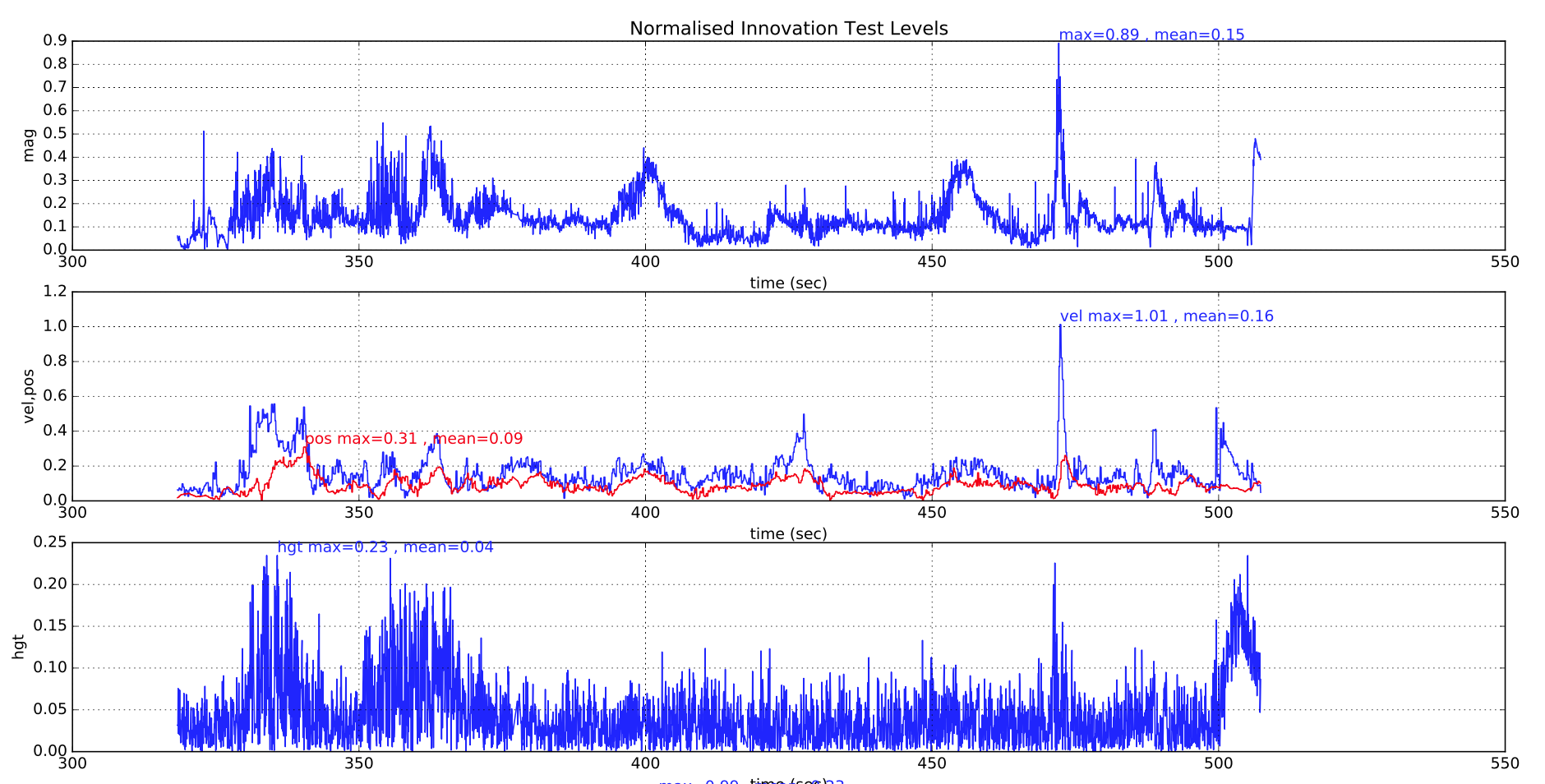
The following plot shows the EKF vibration metrics for a multirotor with good isolation. The landing shock and the increased vibration during takeoff and landing can be seen. Insufficient data has been gathered with these metrics to provide specific advice on maximum thresholds.
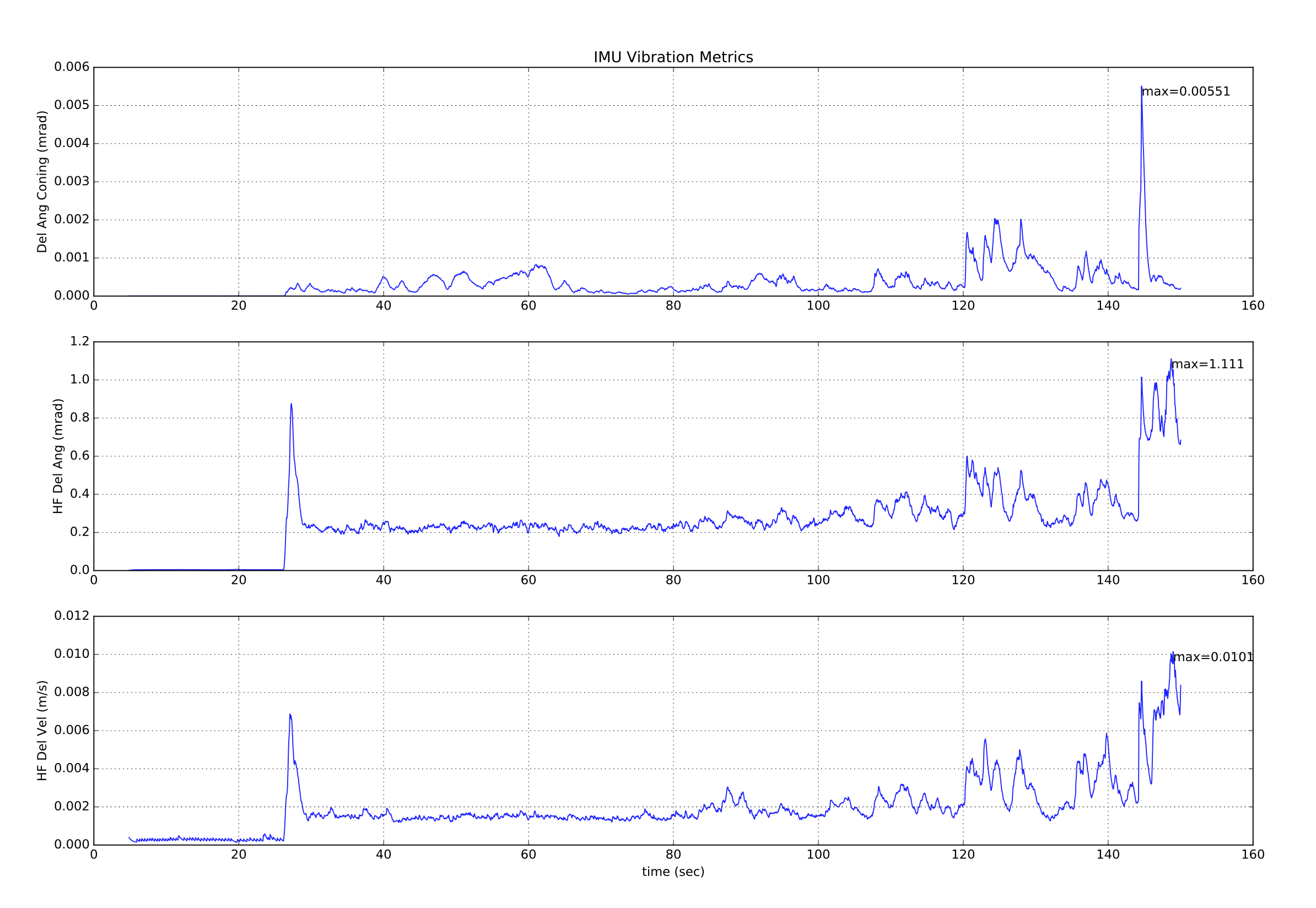
The above vibration metrics are of limited value as the presence of vibration at a frequency close to the IMU sampling frequency (1 kHz for most boards) will cause offsets to appear in the data that do not show up in the high frequency vibration metrics. The only way to detect aliasing errors is in their effect on inertial navigation accuracy and the rise in innovation levels.
In addition to generating large position and velocity test ratios of > 1.0, the different error mechanisms affect the other test ratios in different ways:
Determination of Excessive Vibration
High vibration levels normally affect vertical position and velocity innovations as well as the horizontal components. Magnetometer test levels are only affected to a small extent.
(insert example plots showing bad vibration here)
Determination of Excessive Gyro Bias
Large gyro bias offsets are normally characterised by a change in the value of delta angle bias greater than 5E-4 during flight (equivalent to ~3 deg/sec) and can also cause a large increase in the magnetometer test ratio if the yaw axis is affected. Height is normally unaffected other than extreme cases. Switch on bias value of up to 5 deg/sec can be tolerated provided the filter is given time settle before flying. Pre-flight checks performed by the commander should prevent arming if the position is diverging.
(insert example plots showing bad gyro bias here)
Determination of Poor Yaw Accuracy
Bad yaw alignment causes a velocity test ratio that increases rapidly when the vehicle starts moving due inconsistency in the direction of velocity calculated by the inertial nav and the GPS measurement. Magnetometer innovations are slightly affected. Height is normally unaffected.
(insert example plots showing bad yaw alignment here)
Determination of Poor GPS Accuracy
Poor GPS accuracy is normally accompanied by a rise in the reported velocity error of the receiver in conjunction with a rise in innovations. Transient errors due to multipath, obscuration and interference are more common causes. Here is an example of a temporary loss of GPS accuracy where the multi-rotor started drifting away from its loiter location and had to be corrected using the sticks. The rise in estimator_status.vel_test_ratio to greater than 1 indicates the GPs velocity was inconsistent with other measurements and has been rejected.
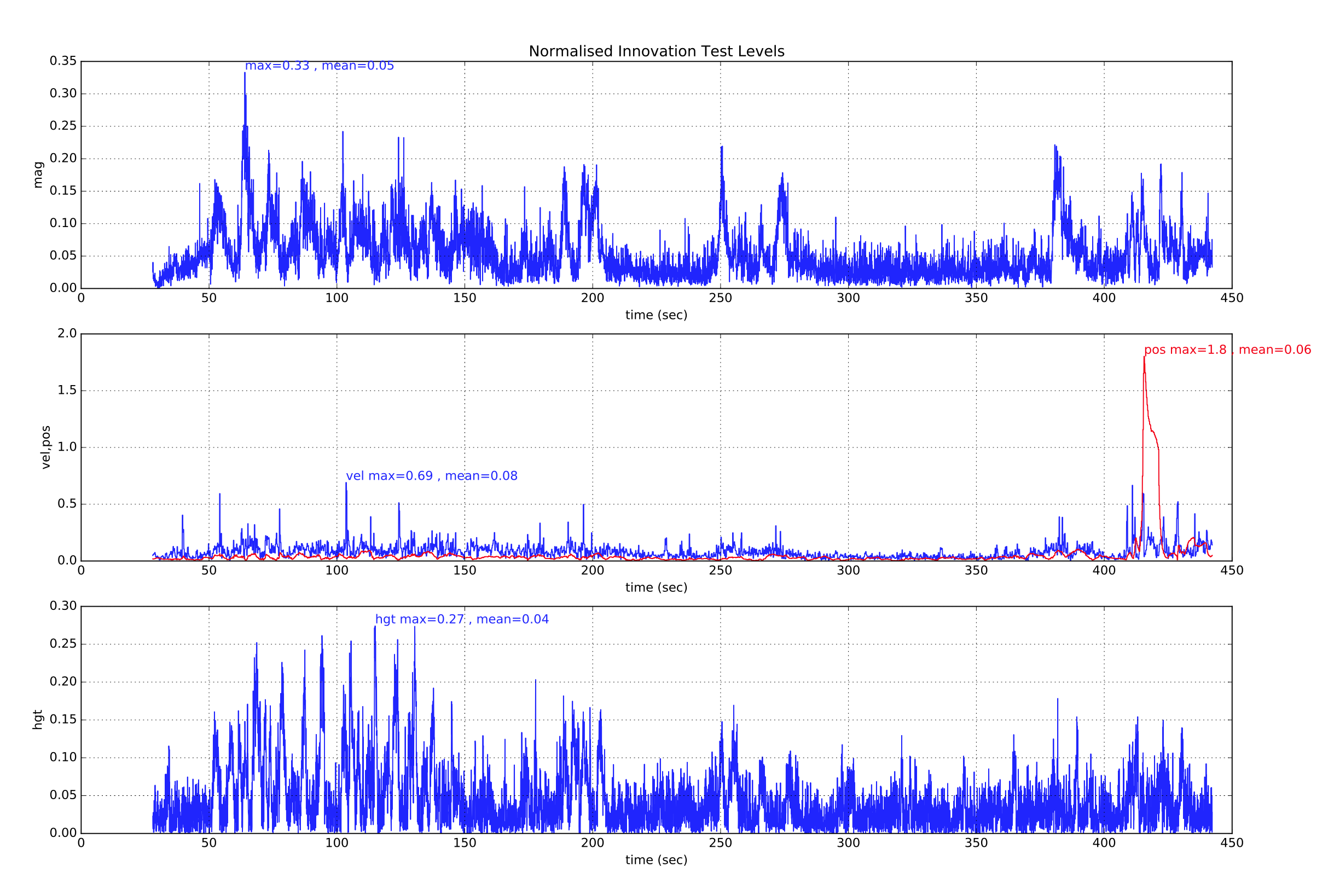
This is accompanied with rise in the GPS receivers reported velocity accuracy which indicates that it was likely a GPS error.
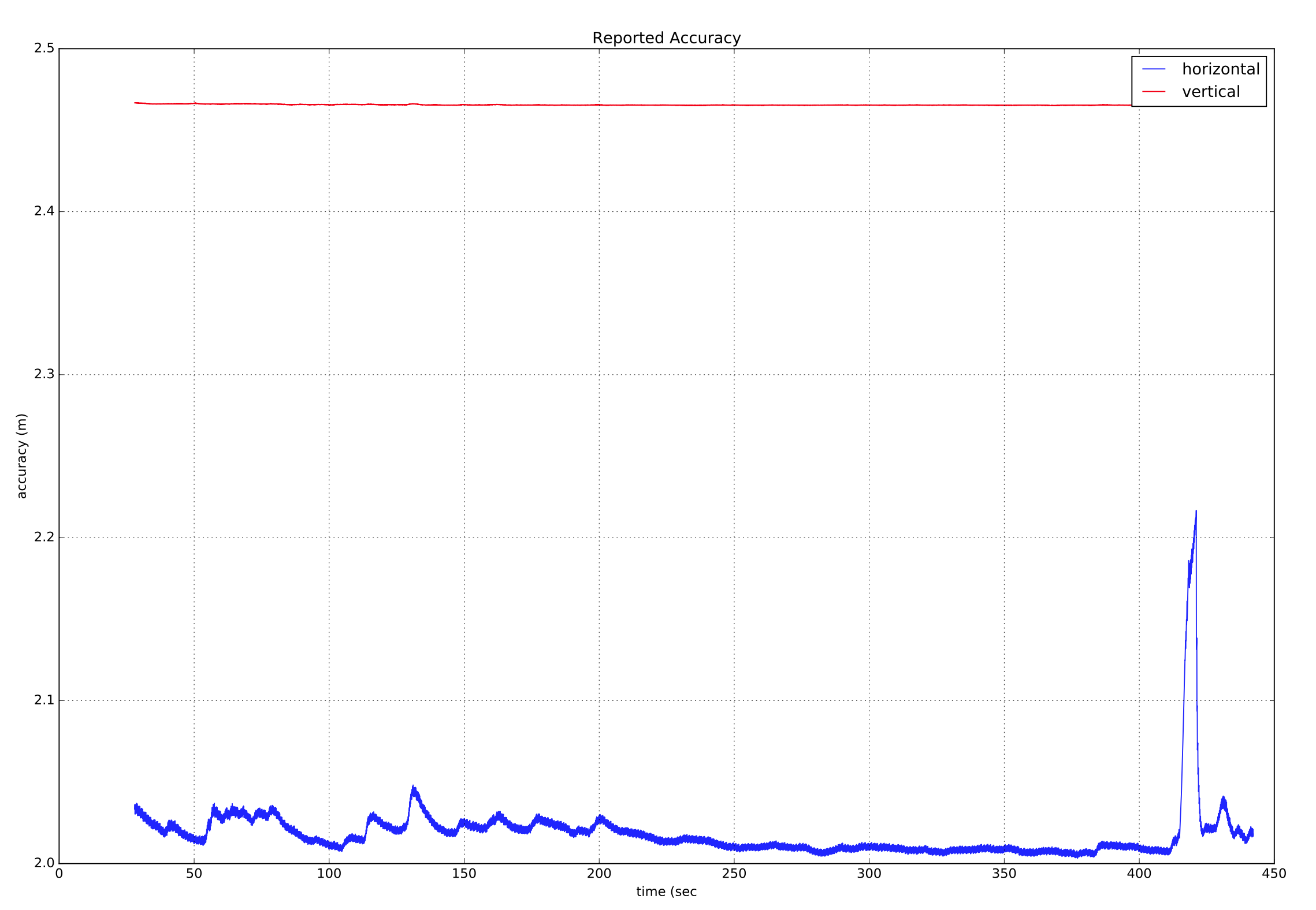
If we also look at the GPS horizontal velocity innovations and innovation variances, we can see the large spike in North velocity innovation that accompanies this GPS 'glitch' event.
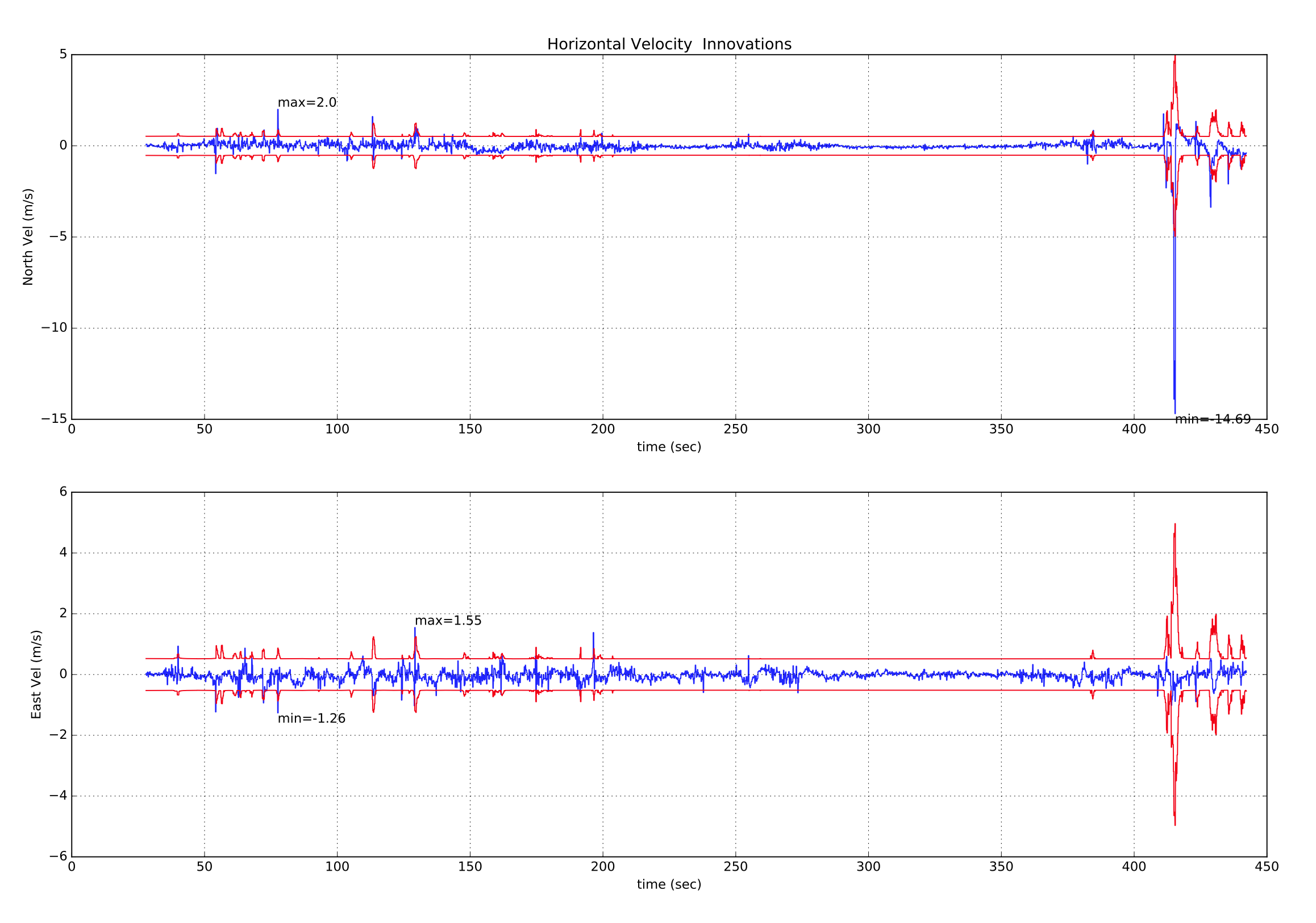
Determination of GPS Data Loss
Loss of GPS data will be shown by the velocity and position innovation test ratios 'flat-lining'. If this occurs, check the other GPS status data in vehicle_gps_position for further information.
The following plot shows the NED GPS velocity innovations ekf2_innovations_0.vel_pos_innov[0 ... 2], the GPS NE position innovations ekf2_innovations_0.vel_pos_innov[3 ... 4] and the Baro vertical position innovation ekf2_innovations_0.vel_pos_innov[5] generated from a simulated VTOL flight using SITL Gazebo.
The simulated GPS was made to lose lock at 73 seconds. Note the NED velocity innovations and NE position innovations 'flat-line' after GPS is lost. Note that after 10 seconds without GPS data, the EKF reverts back to a static position mode using the last known position and the NE position innovations start to change again.
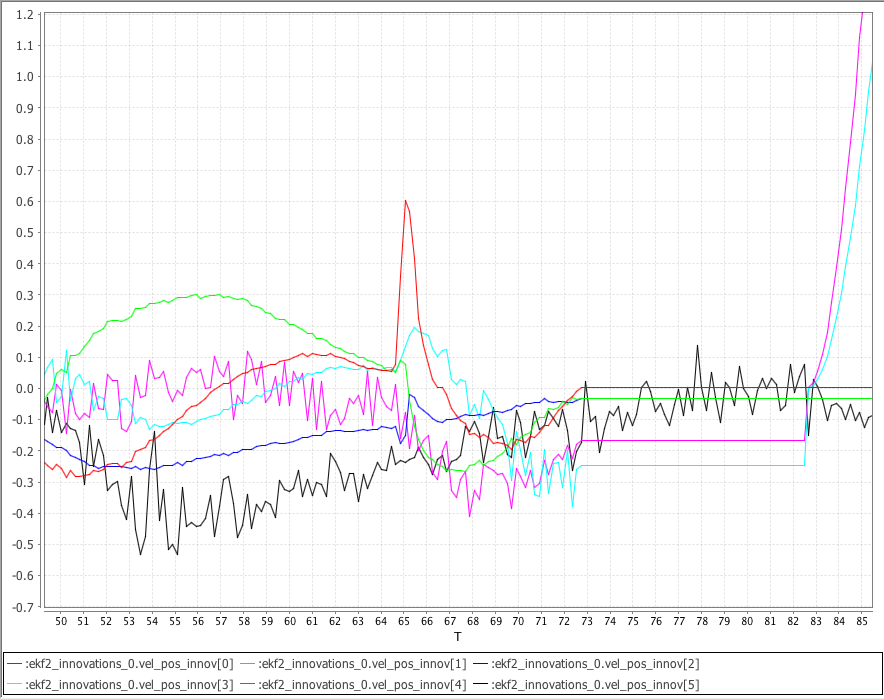
Barometer Ground Effect Compensation
If the vehicle has the tendency during landing to climb back into the air when close to the ground, the most likely cause is barometer ground effect.
This is caused when air pushed down by the propellers hits the ground and creates a high pressure zone below the drone. The result is a lower reading of pressure altitude, leading to an unwanted climb being commanded. The figure below shows a typical situation where the ground effect is present. Note how the barometer signal dips at the beginning and end of the flight.
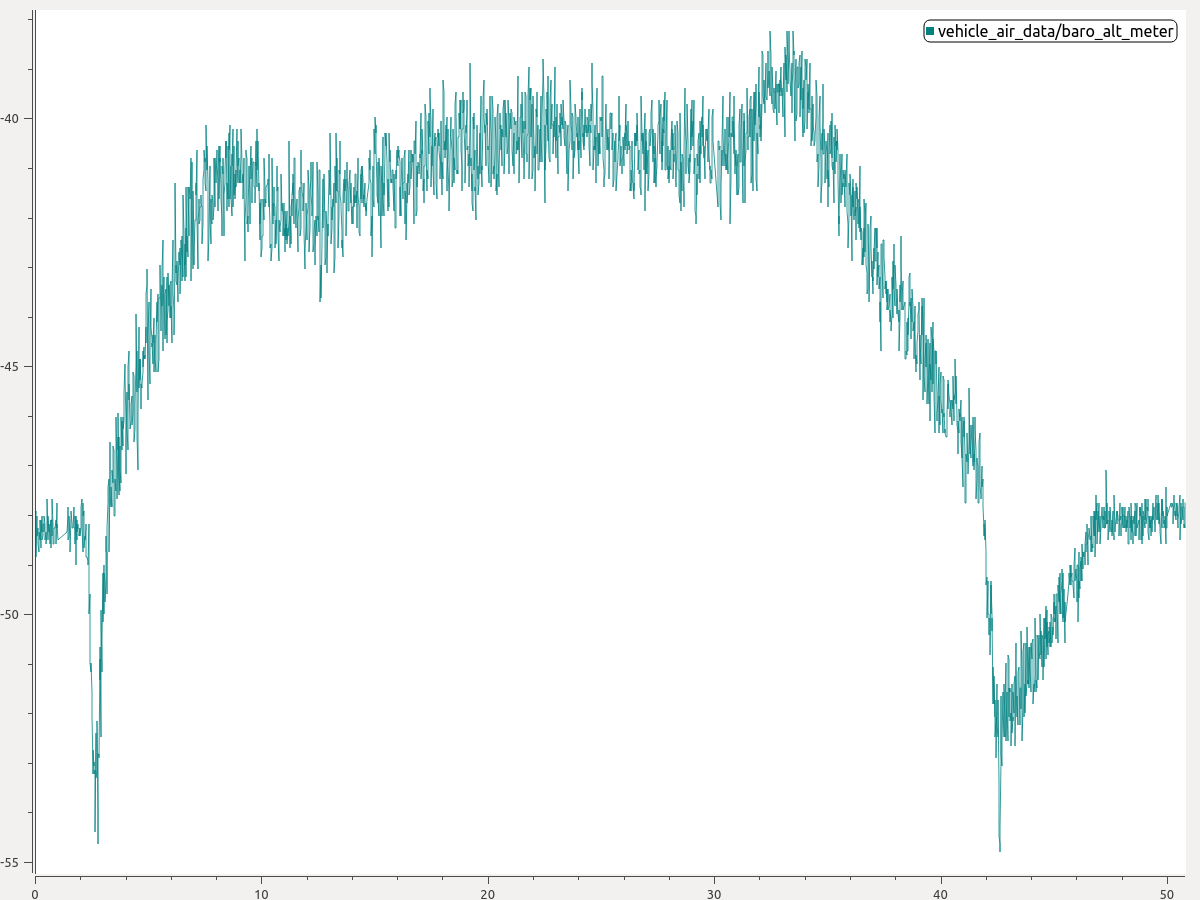
You can enable ground effect compensation to fix this problem:
- From the plot estimate the magnitude of the barometer dip during takeoff or landing. In the plot above one can read a barometer dip of about 6 meters during landing.
- Then set the parameter EKF2_GND_EFF_DZ to that value and add a 10 percent margin. Therefore, in this case a value of 6.6 meters would be a good starting point.
If a terrain estimate is available (e.g. the vehicle is equipped with a range finder) then you can additionally specify EKF2_GND_MAX_HGT, the above ground-level altitude below which ground effect compensation should be activated. If no terrain estimate is available this parameter will have no effect and the system will use heuristics to determine if ground effect compensation should be activated.
Further Information
- PX4 State Estimation Overview, PX4 Developer Summit 2019, Dr. Paul Riseborough): Overview of the estimator, and major changes from 2018/19, and the expected improvements through 2019/20.

